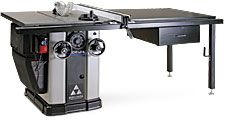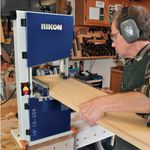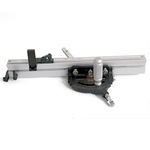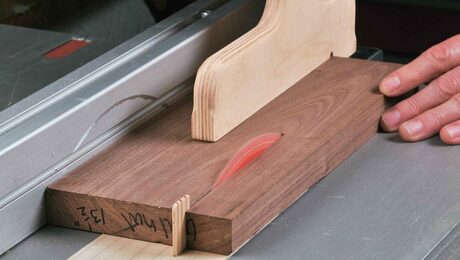Delta - Redesigned Unisaw 10-in. Cabinet Saw
Delta has introduced a completely new Unisaw model
The Delta Unisaw, a 10-in. cabinet saw, was introduced more than 70 years ago. Many woodworkers would argue that for most of those seven decades, it was the gold standard against which all other cabinet saws were judged. Over that time, the Unisaw remained essentially the same. Now, perhaps prompted by a 2008 regulation from Underwriters Laboratories (UL) that requires manufacturers to include a riving knife on all new saws by 2014, Delta has introduced a completely new model. I recently had a chance to use the new saw in the Fine Woodworking workshop. It became immediately clear that this is not your father’s Unisaw.
 |
| World-class riving knife. Delta has created an extremely convenient riving-knife system. To raise, lower, or remove the riving knife, you simply release a front lever with one hand and position the riving knife with the other. |
For starters, Delta made things more convenient by putting the blade-tilt crank on the front, alongside the blade-elevation crank. You no longer have to reach around to the side of the machine to tilt the blade. They also made the tilt scale easy to read. In addition, the two crank systems moved with a smoothness that reminded me of a good metal-working machine.
The new Unisaw also has a wonderful riving-knife system that uses just one knife to do the job of two. That’s possible because the knife can be locked in either of two positions. In the low position, it works as a low-profile (shark fin) knife, allowing you to make non-through cuts, like slots or grooves. In the high position, it’s a high-profile knife that accepts a blade cover and anti-kickback pawls. Delta made it especially easy to lock or unlock the knife. One hand pulls a lever at the front of the cabinet while the other hand raises or lowers the knife. There is no need to remove the throat plate.
Using a testing-quality straightedge and feeler gauges, I checked the table for flatness. On average it was under 0.001 in., an excellent number. The cast-iron extension tables were almost as flat. Measured with a dial indicator, the arbor-flange runout was 0.0005 in. With the blade at 90º to the table, the blade-to-miter- gauge runout was 0.004 in. across a 7-1/2-in. length. When the blade was tilted to 45º, the blade-to-miter-gauge runout measured 0.003 in. across 6-1/2 in. All are very good numbers.
 |
| With the riving knife in the raised (high-profile) position, it’s easy to snap on the anti-kickback pawls and blade cover |
A standard Biesemeyer rip fence is sturdy, slides easily, and locks with little effort. The saw has a decent miter gauge that repeatedly returned to 90º. Also standard is a storage drawer that mounts under the side table. The 3-hp, 230-volt motor had no trouble ripping and crosscutting 1-3/4-in.-thick maple. A 5-hp motor is an option.
It was hard to find anything wrong with the new Unisaw. OK, dust collection was only average. Expect to pay about $2,600 for the saw with a 3-hp motor and a 36-in. rip fence. The same saw with a 52-in. rip fence costs about $2,650. For information, go to www.deltamachinery.com.
*Editor’s Note: Updated 8/09. The Unisaw was introduced in 1938, 71 years ago and not 40, as originally stated in the article.
More from FineWoodworking.com:
- The Delta Unisaw Unifence is a Work-Altering Revelation
- More on the Delta Disappearing Tablesaw Splitter
- Tablesaws Under Siege: New Regulations
Fine Woodworking Recommended Products

Rikon 10-3061 10-in. Deluxe Bandsaw
The saw has two speeds: 3,280 sfpm (surface feet per minute) for wood and 1,515 sfpm for soft metals and some plastics.

Freud Super Dado Saw Blade Set 8" x 5/8" Bore

JessEm Mite-R Excel II Miter Gauge






















Log in or create an account to post a comment.
Sign up Log in